Introduction:
An autotransformer is the one which consists of a single winding, part of which acts as the primary winding of the transformer, and some part of which acts the secondary winding, which can be varied by switching between the contacts of the transformer. By varying the contact of the switch we can change the number of turns which are accommodated in the secondary winding. Since the output voltage depends upon the number of turns of the secondary winding, so in this way the voltage output can also be varied. For this reason, an autotransformer is also known as a “Variac” because it is mostly used to vary (step up or step down ) the output voltage which has to be supplied to the circuit.
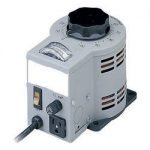
Fig: Autotransformer
Construction and working of an Auto Transformer
In general transformers, two windings are magnetically linked to each other, but re physically separated from each other. But in an autotransformer, both the primary and secondary windings are connected, both physically and magnetically.
The internal construction of an autotransformer is shown in the figure below:
Here,
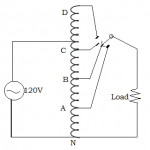
Fig: Autotransformer tapping’s
Here it can be seen that there is only a single winding, on which several points have been marked, and each point has an equal number of turns, i.e. 40 turns between two consecutive points on the winding, which means 40 volts between those two points.
The primary voltage which is of 120 volts, in this case, is supplied between the points C and N, as these points accommodate 120 turns as well. So the winding between point C and N is regarded as the Primary Winding over here.
Now the secondary winding will be the one, across which we connect the external load. Since autotransformers have a varying output voltage, so we connect a switch with the load, so that the contacts can be varied to step up or step down the secondary voltage. So as shown in the figure, we make one end of the load as a fixed end and connect it to the point N.
The other end of the load is connected on the switch, and the point to which the switch will be connected; will be the other point of the secondary winding. For example, in this figure, the secondary winding is between B and N.
In the transformer in the figure, a switch is used to switch between the points A, B, C and D. But if this switch is replaced by a sliding Tap, then the voltage could be varied continuously and this transformer could also be known as a “Variac”.
Autotransformer Design
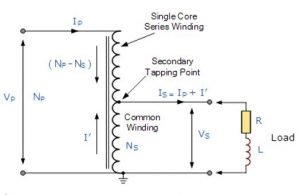
When the primary current IP is flowing through the single winding in the direction of the arrow as shown, the secondary current, IS, flows in the opposite direction. Therefore, in the portion of the winding that generates the secondary voltage, VS the current flowing out of the winding is the difference of IP and IS.
The Autotransformer can also be constructed with more than one single tapping point. Auto-transformers can be used to provide different voltage points along its winding or increase its supply voltage concerning its supply voltage VP as shown.
Autotransformer with Multiple Tapping Points
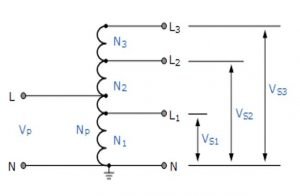
The standard method for marking an auto-transformer winding is to label it with capital (upper case) letters. So for example, A, B, Z., Etc. to identify the supply end. Generally, the common neutral connection is marked as N or n. For the secondary tapping’s, suffix numbers are used for all tapping points along the auto-transformers primary winding. These numbers generally start at number “1” and continue in ascending order for all tapping points as shown.
Autotransformer Terminal Markings
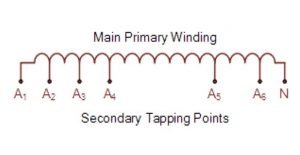
An autotransformer is used mainly for the adjustments of line voltages to either change its value or to keep it constant. If the voltage adjustment is by a small amount, either up or down, then the transformer ratio is small as VP and VS are nearly equal. Currents IP and IS are also nearly equal.
Therefore, the portion of the winding which carries the difference between the two currents can be made from a much smaller conductor size, since the currents are much smaller saving on the cost of an equivalent double wound transformer.
However, the regulation, leakage inductance, and physical size (since there is no second winding) of an autotransformer for a given VA or KVA rating are less than for a double wound transformer.
Autotransformers are much cheaper than conventional double wound transformers of the same VA rating. When deciding upon using an autotransformer it is usual to compare its cost with that of an equivalent double wound type.
This is done by comparing the amount of copper saved in the winding. If the ratio “n” is defined as the ratio of the lower voltage to the higher voltage, then it can be shown that the saving in copper is: n*100%. For example, the saving in copper for the two autotransformers would be:
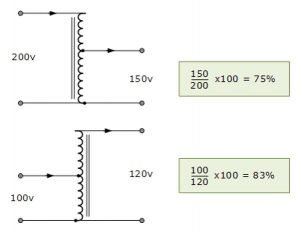
Applications of an Auto Transformer
As explained by the figure, an autotransformer can supply a varying secondary voltage to the externally connected load. So this is mostly used in applications where a continuously varying voltage output is required. Some of its applications are listed below:
- It is used in electronics testing centers where continuously varying voltage supplies are required.
- In amplifiers or boosters, where high voltages are required.
- In other audio devices like speakers, these transformers are used for matching the impedance and adapting the device to a continuous voltage supply.
- At places like power stations which initially need to step down the voltage, then increase it to match the voltage required by the device at the receiving end.
- Since only one winding is required, so these transformers are cost-efficient and relatively smaller.
Advantages of Auto Transformers
- These are more efficient and require lower excitation currents than conventional transformers.
- The varying voltage is more easy and smooth in autotransformers, as compared to the conventional step up and step down transformers.
- These are used in voltage stabilizers, variable D.C arrangements (with a diode bridge) in laboratories, motor, starters, dimmers, etc.
